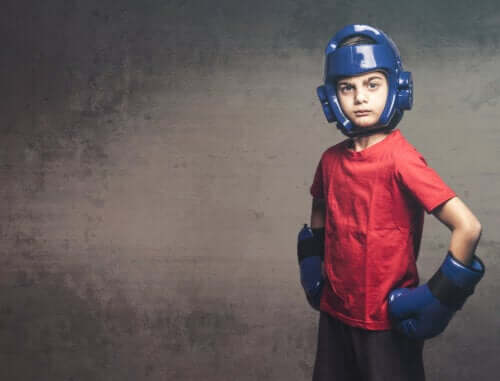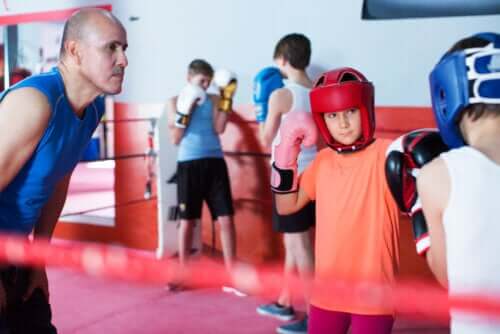Are Combat Sports Good for Your Kids?

Practicing sports on a regular basis is good for children’s bodies, minds and emotions. Besides practicing physical education at school, it’s positive for our children to partake in other sports they may like. They could be team, individual or even combat sports.
What are combat sports?
As opposed to martial arts (more specific practices which aim to develop emotions), combat sports or fighting sports aim to promote competition through physical contact. Therefore, boxing, kickboxing, Muay Thai and mixed martial arts are combat sports.
Every combat sport includes different body parts, such as fists, elbows or knees, in order to face your opponent. In addition, there are different techniques and tactics depending on its classification. Moreover, people need to wear certain outfits and accessories.

What’s more, combat sports, like every kind of sport, are practiced in proper places with rules and referees. All this promotes the safety of the competitors.
Are combat sports aggressive and violent?
Yes and no. Yes, they are, because they may seem aggressive and violent since they require the use of strength. As a result, competitors may suffer from certain kinds of physical injuries while facing each other.
At the same time, they’re not violent or aggressive because there are rules to follow and control of the situation. In a way, the violence is justified. However, referees condemn any violent attitude with the purpose of injuring their rival outside the rules of the competition.
“In the ring we have a referee to stop the fight if one man should become too hurt physically. Boxing is nothing like going to war with machine guns, bazookas, hand grenades and bomber airplanes.”
– Mohamed Ali –
Are combat sports good for your children?
It’s just like in the case of the previous question: the answer is yes and no. If children think they can use their strength and what they learn outside the sport environment, the answer is no. On the other hand, if they do it properly, it can be as good as any other sport.
These are some of the important benefits of practicing combat sports for the integral development of children:
- Promotes and improves physical development. This is because it improves muscle and bone strength, and cardiovascular capacity.
- Helps in maintaining a healthy weight, avoiding diseases like obesity and diabetes.
- Helps in adopting habits and routines related to diet, rest and hygiene.
- Promotes the acquisition of values, such as effort, determination and discipline.
- Improves self-esteem, trust and motivation in children and teenagers.

- Improves mood, because, it reduces anxiety and stress.
- Promotes socializing, teamwork, solidarity and empathy. Furthermore, it promotes the respect for rules and guidelines to follow.
- Fosters healthy competition, because it helps children manage wins and losses.
Fighting only in the ring…
It’s very important to educate our children to respect rules and guidelines to follow in any kind of sport. They also need to understand that practicing sports is about sharing and having fun. Also, hitting, kicking or screaming aren’t valid attitudes outside the rules of the game.
Finally, if children understand that there’s no excuse for using violence in everyday life, combat sports might be good for them. They may be as good as any other sport, including important benefits for their social, physical and emotional development.
Practicing sports on a regular basis is good for children’s bodies, minds and emotions. Besides practicing physical education at school, it’s positive for our children to partake in other sports they may like. They could be team, individual or even combat sports.
What are combat sports?
As opposed to martial arts (more specific practices which aim to develop emotions), combat sports or fighting sports aim to promote competition through physical contact. Therefore, boxing, kickboxing, Muay Thai and mixed martial arts are combat sports.
Every combat sport includes different body parts, such as fists, elbows or knees, in order to face your opponent. In addition, there are different techniques and tactics depending on its classification. Moreover, people need to wear certain outfits and accessories.

What’s more, combat sports, like every kind of sport, are practiced in proper places with rules and referees. All this promotes the safety of the competitors.
Are combat sports aggressive and violent?
Yes and no. Yes, they are, because they may seem aggressive and violent since they require the use of strength. As a result, competitors may suffer from certain kinds of physical injuries while facing each other.
At the same time, they’re not violent or aggressive because there are rules to follow and control of the situation. In a way, the violence is justified. However, referees condemn any violent attitude with the purpose of injuring their rival outside the rules of the competition.
“In the ring we have a referee to stop the fight if one man should become too hurt physically. Boxing is nothing like going to war with machine guns, bazookas, hand grenades and bomber airplanes.”
– Mohamed Ali –
Are combat sports good for your children?
It’s just like in the case of the previous question: the answer is yes and no. If children think they can use their strength and what they learn outside the sport environment, the answer is no. On the other hand, if they do it properly, it can be as good as any other sport.
These are some of the important benefits of practicing combat sports for the integral development of children:
- Promotes and improves physical development. This is because it improves muscle and bone strength, and cardiovascular capacity.
- Helps in maintaining a healthy weight, avoiding diseases like obesity and diabetes.
- Helps in adopting habits and routines related to diet, rest and hygiene.
- Promotes the acquisition of values, such as effort, determination and discipline.
- Improves self-esteem, trust and motivation in children and teenagers.

- Improves mood, because, it reduces anxiety and stress.
- Promotes socializing, teamwork, solidarity and empathy. Furthermore, it promotes the respect for rules and guidelines to follow.
- Fosters healthy competition, because it helps children manage wins and losses.
Fighting only in the ring…
It’s very important to educate our children to respect rules and guidelines to follow in any kind of sport. They also need to understand that practicing sports is about sharing and having fun. Also, hitting, kicking or screaming aren’t valid attitudes outside the rules of the game.
Finally, if children understand that there’s no excuse for using violence in everyday life, combat sports might be good for them. They may be as good as any other sport, including important benefits for their social, physical and emotional development.
All cited sources were thoroughly reviewed by our team to ensure their quality, reliability, currency, and validity. The bibliography of this article was considered reliable and of academic or scientific accuracy.
- Enriquez Caro, L. y Castro Bermudez, E., I. (2012). La violencia en los deportes de combate. Su perpectiva sociológica en la formación del atleta. Recuperado de https://www.efdeportes.com/efd168/la-violencia-en-los-deportes-de-combate.htm
- Torres García, U. (2011). Conjunto de actividades físico recreativas para incrementar la incorporación de niños de 8 a 12 años a deportes de combate en el Consejo Popular José Martí (Doctoral dissertation, Universidad Central “Marta Abreu” de Las Villas. Facultad de Cultura Física. Centro de Estudios de Cultura Física). Recuperado de http://dspace.uclv.edu.cu/bitstream/handle/123456789/7348/ULISES%20TORRES%20GARC%c3%8dA%20Conjunto%20de%20actividades%20f%c3%adsico%20recreativas%20para.pdf?sequence=1&isAllowed=y
- Cagigal, J. (1990). Deporte y agresión. Editorial Alianza. Madrid. España.
This text is provided for informational purposes only and does not replace consultation with a professional. If in doubt, consult your specialist.








